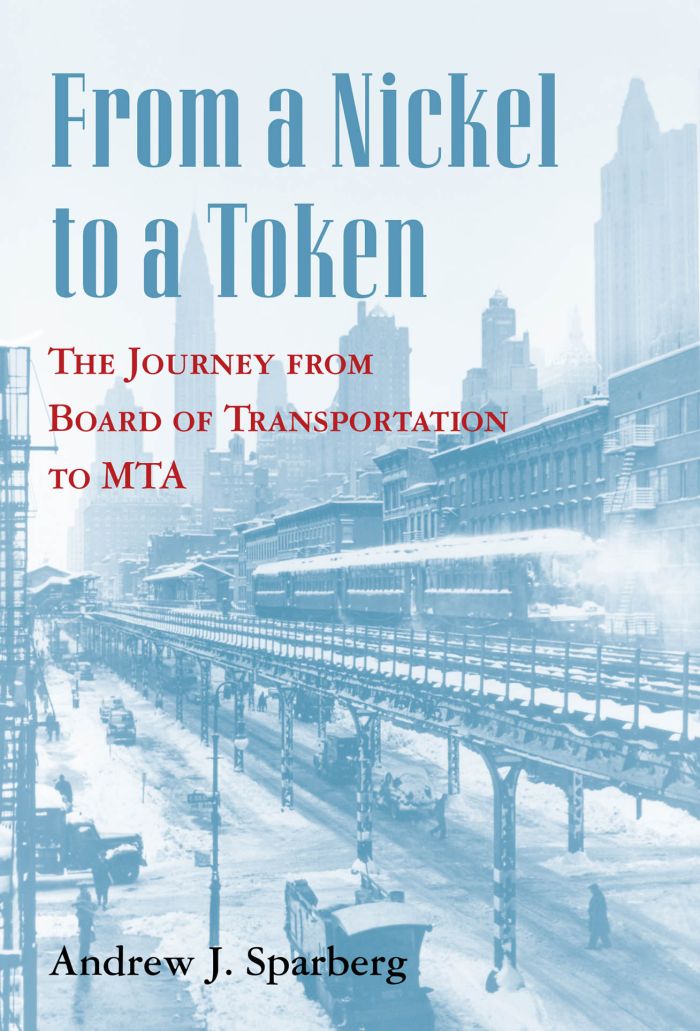From a Nickel to a Token
The Journey from Board of Transportation to MTA

This book can be opened with

Streetcars “are as dead as sailing ships,” said Mayor Fiorello LaGuardia in a radio speech, two days before Madison Avenue’s streetcars yielded to buses. LaGuardia was determined to eliminate streetcars, demolish pre-1900 elevated lines, and unify the subway system, a goal that became reality in 1940 when the separate IRT, BMT, and IND became one giant system under full public control.
In this fascinating micro-history of New York’s transit system, Andrew Sparberg examines twenty specific events between 1940 and 1968, book ended by subway unification and the MTA’s creation. From a Nickel to a Token depicts a potpourri of well-remembered, partially forgotten, and totally obscure happenings drawn from the historical tapestry of New York mass transit. Sparberg deftly captures five boroughs of grit, chaos, and emotion grappling with a massive and unwieldy transit system.
During these decades, the system morphed into today’s familiar network. The public sector absorbed most private surface lines operating within the five boroughs, and buses completely replaced streetcars. Elevated lines were demolished, replaced by subways or, along Manhattan’s Third Avenue, not at all. Beyond the unification of the IND, IRT, and BMT, strategic track connections were built between lines to allow a more flexible and unified operation. The oldest subway routes received much needed rehabilitation. Thousands of new subway cars and buses were purchased. The sacred nickel fare barrier was broken, and by 1968 a ride cost twenty cents.
From LaGuardia to Lindsay, mayors devoted much energy to solving transit problems, keeping fares low, and appeasing voters, fellow elected officials, transit management, and labor leaders. Simultaneously, American society was experiencing tumultuous times, manifested by labor disputes, economic pressures, and civil rights protests.
Featuring many photos never before published, From a Nickel to a Token is a historical trip back in time to a multitude of important events.
“A very strong discussion of a time of evolution in the New York City transit system.”
After many years of deep and effective involvement in the operation of one of the world's most complex suburban rail operations (Long Island Rail Road), Andy Sparberg has now turned his attention to one of the world's most complex rapid transit operations. His research on not just what happened but why, and more important what we can learn from history, is in this new volume. I look forward to learning from it.
Mr. Sparberg traces nearly three decades at the dawn of public ownership, from the city's acquisition and unification of the subway system, to the demolition of the elevated lines, to the replacement of trolleys by buses, to the elimination of the politically sacrosanct nickel fare and the first air-conditioned subways.——The New York Times
In each of the book's 20 chapters, the author investigates a particular event that altered New York City transit during those 28 tumultuous years in New York and American History.
There never has been a better, more comprehensive history of New York’s elaborate transit system than From a Nickel to a Token. Better still, Andy Sparberg takes us on this comprehensive journey in a most readable fashion. This is not a book merely for transit buffs, it should be a must-read for any New Yorker who wants an inside view of his and her city during a gripping, tumultuous era. Nobody in the transit-writing business can do a better job than Sparberg has done for us.

